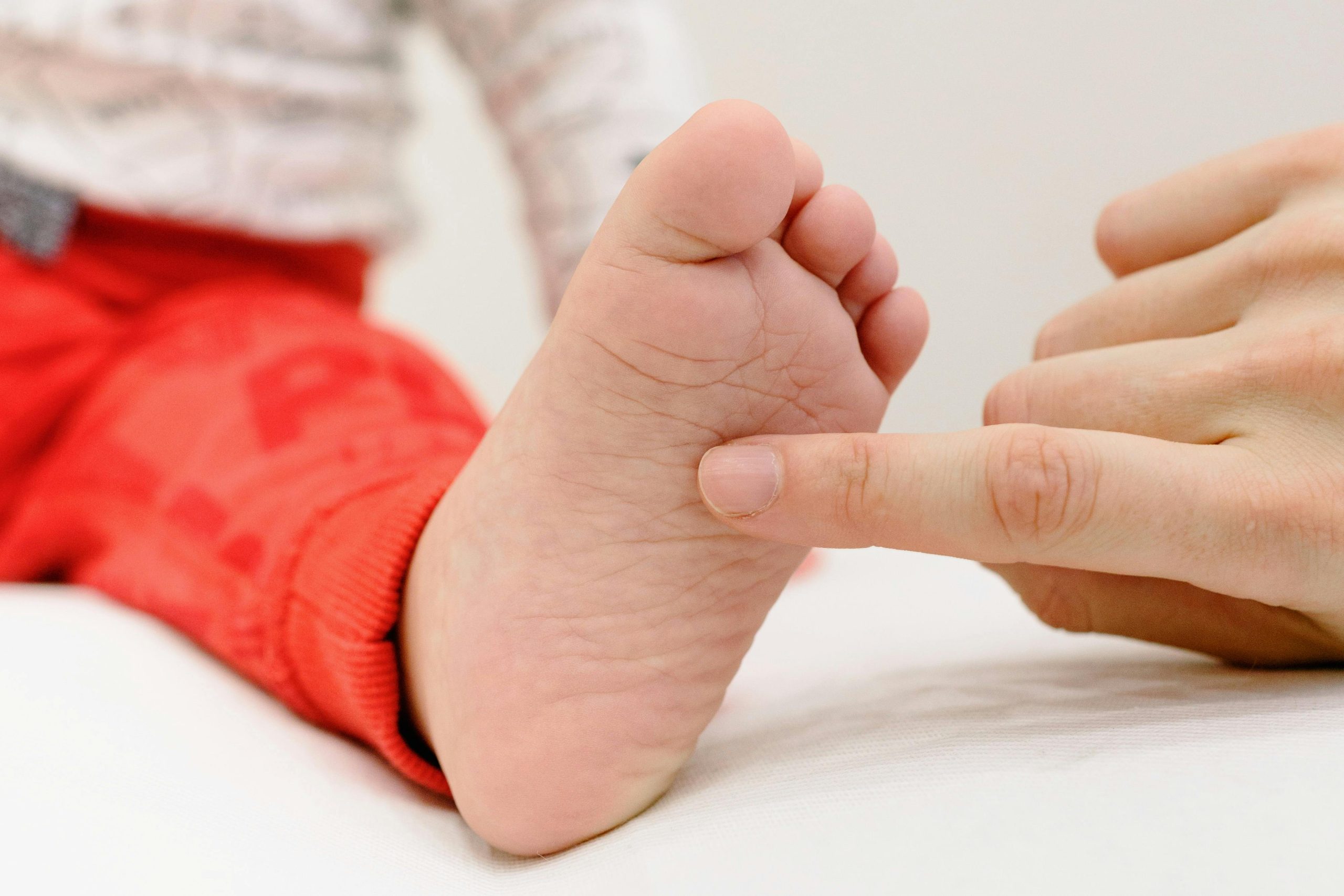

By Debra Silver, Paediatric Physiotherapist at Kidswell Health
It can be worrying to notice that your baby’s foot doesn’t look quite straight after birth. However, positional talipes is actually very common in newborns and in most cases, it improves quickly with gentle stretches, movement, and physiotherapy support.
In this guide, we explain what positional talipes is, what causes it, how long it takes to correct, and when to seek specialist advice from a paediatric physiotherapist.
Positional talipes is a condition where a baby’s foot or feet appear to be turned inwards or downwards at birth. It’s caused by the baby’s position in the womb and affects around 1 in 20 newborns.
Unlike structural clubfoot (talipes equinovarus), positional talipes is not a bone or joint deformity. The bones and joints are normal, it’s simply the muscles and soft tissues that are tight from being held in one position before birth.
Most babies with positional talipes have flexible feet that can be gently moved into a normal position without pain.
The main cause of positional talipes is the baby’s position in the womb during late pregnancy. Limited space can lead to tightness in the muscles or tendons around the foot and ankle.
Factors that increase the likelihood include:
It’s important to remember positional talipes is not caused by anything a parent has done – and it usually improves quickly after birth with simple exercises or physiotherapy.
Positional talipes is often noticed at birth by the midwife, paediatrician, or GP. The key difference from structural clubfoot is that the foot is flexible and can be moved into the normal position.
If the foot feels stiff or doesn’t move easily, your baby may be referred to a paediatric physiotherapist for assessment and treatment.
Most cases of positional talipes in newborns start to improve within a few weeks of gentle stretching and positioning exercises.
With regular physiotherapy or at-home exercises, the condition typically resolves completely by 3 to 6 months.
If positional talipes at 6 months is still noticeable, or if the foot seems stiff, further assessment is recommended to rule out a structural issue.
In rare cases, positional talipes at 1 year old may persist – often due to untreated tightness or reduced mobility, and early physiotherapy can still make a big difference.
If your baby’s foot doesn’t appear to be improving after a few months, it’s important to have a specialist review. Sometimes, ongoing tightness, muscle imbalance, or reduced movement can cause the foot to turn inwards again.
A paediatric physiotherapist can:
Early intervention helps prevent long-term effects and ensures your baby develops normal movement patterns as they start to sit, crawl, and walk.
For most babies, positional talipes will resolve completely without any long-term issues. Once corrected, children develop normally and participate in all physical activities.
If the condition goes untreated or is mistaken for structural clubfoot, it may lead to:
Fortunately, with physiotherapy and early support, these problems can almost always be avoided.
Physiotherapy is one of the most effective treatments for positional talipes. The focus is on gentle stretching, strengthening, and helping the foot return to its normal position.
At Kidswell Health, our paediatric physiotherapist, Debra Silver, has extensive experience helping babies and families manage conditions like positional talipes.
Sessions are designed to be playful, comfortable, and reassuring for both babies and parents.
Most babies respond quickly and parents often see improvement after just a few sessions.
You should speak to your GP, midwife, or a paediatric physiotherapist if:
Early assessment helps ensure your baby receives the right care before developmental milestones like sitting or walking begin.
At Kidswell Health, we provide expert paediatric physiotherapy in North London for babies and children with movement or developmental concerns, including positional talipes, torticollis, delayed sitting, and coordination difficulties.
Our sessions are family-centred, playful, and tailored to your baby’s needs, helping them build strength, confidence, and healthy movement patterns from the start.
Book a physiotherapy assessment today to support your baby’s early development and recovery.
What’s the difference between positional talipes and clubfoot?
Positional talipes is caused by tight muscles from being in one position in the womb. Clubfoot involves structural changes in the bones and joints and requires specialist orthopaedic care.
How long does positional talipes take to correct?
Most babies improve within 4-8 weeks with stretching or physiotherapy. Some may take up to 3-6 months for full correction.
Can positional talipes affect walking?
Not usually. Once treated, babies develop normal movement and walking patterns. Untreated cases may lead to slight tightness or altered gait.
Does physiotherapy really help?
Yes. Physiotherapy helps improve flexibility, strengthen muscles, and guide parents on positioning and exercises. Early intervention gives the best outcomes.
What if my baby’s positional talipes isn’t improving?
If there’s no improvement after a few weeks, or you’re unsure whether your baby’s feet are flexible, book a physiotherapy assessment for further guidance.
Learn about RSV symptoms, causes, and treatment. Understand how to spot signs early, protect your baby and when to seek…
When a child is finding emotions, behaviour, learning or relationships difficult, parents often come across many different professional titles and…
Learn the symptoms, causes and treatment of RSV in babies, plus expert advice on how to protect your child this…
By Debra Silver, Paediatric Physiotherapist at Kidswell Health Watching your baby reach new milestones is one of the most exciting…
Dr Mitsu Shah explains common side effects of baby vaccinations.
Dr Mitsu Shah shares expert tips to prepare for your baby’s first vaccination.